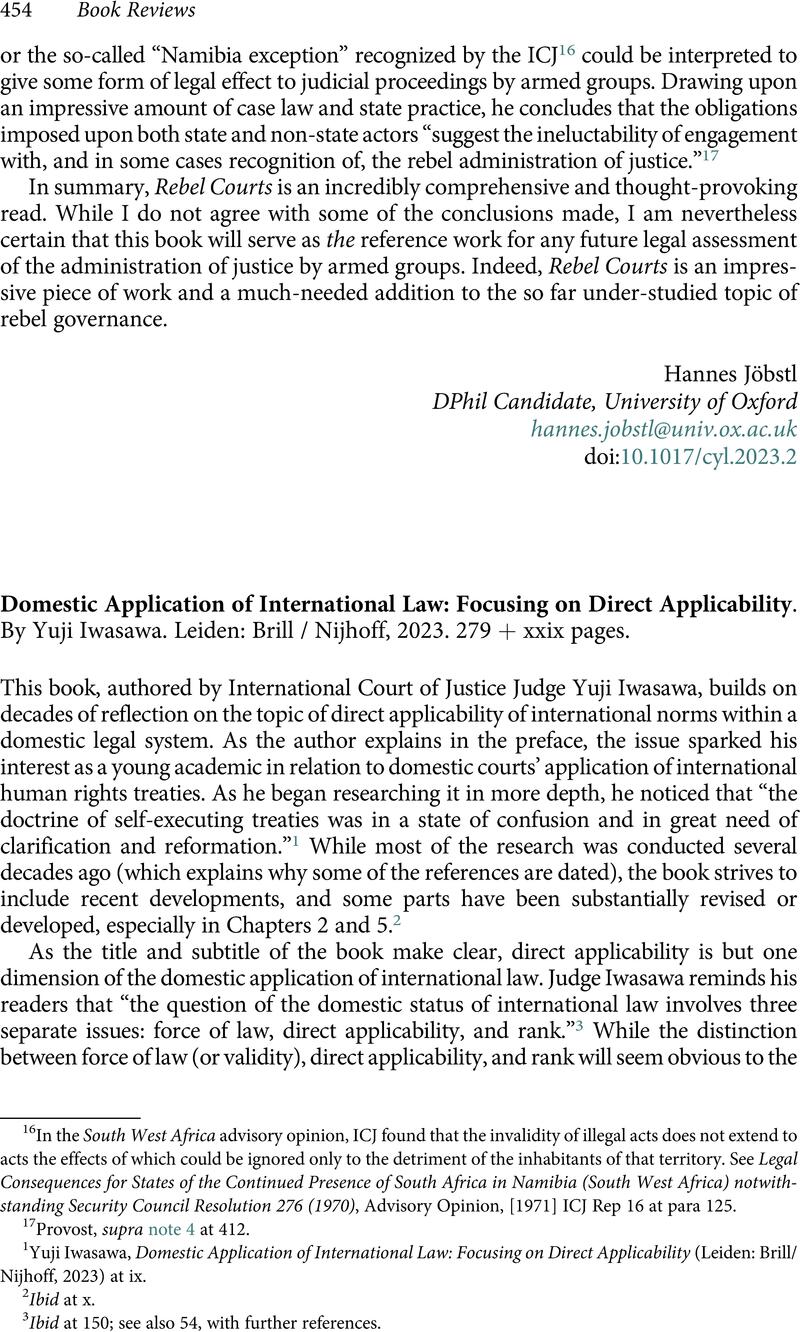No CrossRef data available.
Article contents
Domestic Application of International Law: Focusing on Direct Applicability. By Yuji Iwasawa. Leiden: Brill / Nijhoff, 2023. 279 + xxix pages.
Review products
Published online by Cambridge University Press: 28 November 2023
Abstract

- Type
- Book Reviews/Recensions de livres
- Information
- Canadian Yearbook of International Law/Annuaire canadien de droit international , Volume 60 , November 2023 , pp. 454 - 460
- Copyright
- © The Canadian Yearbook of International Law/Annuaire canadien de droit international 2023
References
1 Iwasawa, Yuji, Domestic Application of International Law: Focusing on Direct Applicability (Leiden: Brill/Nijhoff, 2023) at ixGoogle Scholar.
2 Ibid at x.
3 Ibid at 150; see also 54, with further references.
4 Ibid at 54–56.
5 Ibid at 10ff.
6 Jurisdiction of the Courts of Danzig, Advisory Opinion, (1928) PCIJ (Ser B) No 15.
7 Ibid at 184.
8 Ibid at 146.
9 Ibid at 15.
10 Ibid at 15ff.
11 Ibid at 183.
12 Ibid at 139.
13 On this term, see Ammann, Odile, Domestic Courts and the Interpretation of International Law: Methods and Reasoning Based on the Swiss Example (Leiden: Brill/Nijhoff, 2019) at 54ffGoogle Scholar.
14 Vienna Convention on the Law of Treaties, 23 May 1969, 1155 UNTS 331, Can TS 1980 No 37 (entered into force 27 January 1980).
15 Iwasawa, supra note 1 at 196.
16 See e.g. regarding the Swiss case law. Ibid at 81ff.
17 Ibid at 160.
18 Ibid.
19 Ibid at 161.
20 Ibid at 162.
21 Ibid at 30ff; Convention for the Protection of Human Rights and Fundamental Freedoms, 4 November 1950, 213 UNTS 221 (entered into force 3 September 1953).
22 Iwasawa, supra note 1 at 177.
23 For a similar call for greater methodological rigour, see ibid.
24 Ibid at 54ff.
25 Ibid at 56ff.
26 Ibid at 60.
27 See e.g. ibid at 139.
28 Ibid at 147; see also 149ff.
29 See e.g. ibid at 279.
30 Ibid at 139.
31 Ibid at 141.
32 Ibid at 225.
33 See ibid at 180ff.
34 The sword versus shield metaphor is used in at least two different ways. As Judge Iwasawa explains, “this use of the terms ‘sword’ and ‘shield’ is different from the use of the same terms to explain the difference between the positive application and negative application of international law in domestic law.” Ibid at 277ff. On this second meaning, see ibid at 200.
35 See e.g. ibid at 120, 277.
36 Ibid at 278.
37 Ibid at 279.
38 See e.g. ibid at 70.
39 See ibid at 60ff.
40 See also ibid at xixff.
41 Ibid at x.
42 See ibid at 8ff.
43 Ibid at 69.
44 Ibid at 70.
45 Ibid at x.
46 Ibid.
47 Ibid at 226ff.
48 Ibid at 231ff.


